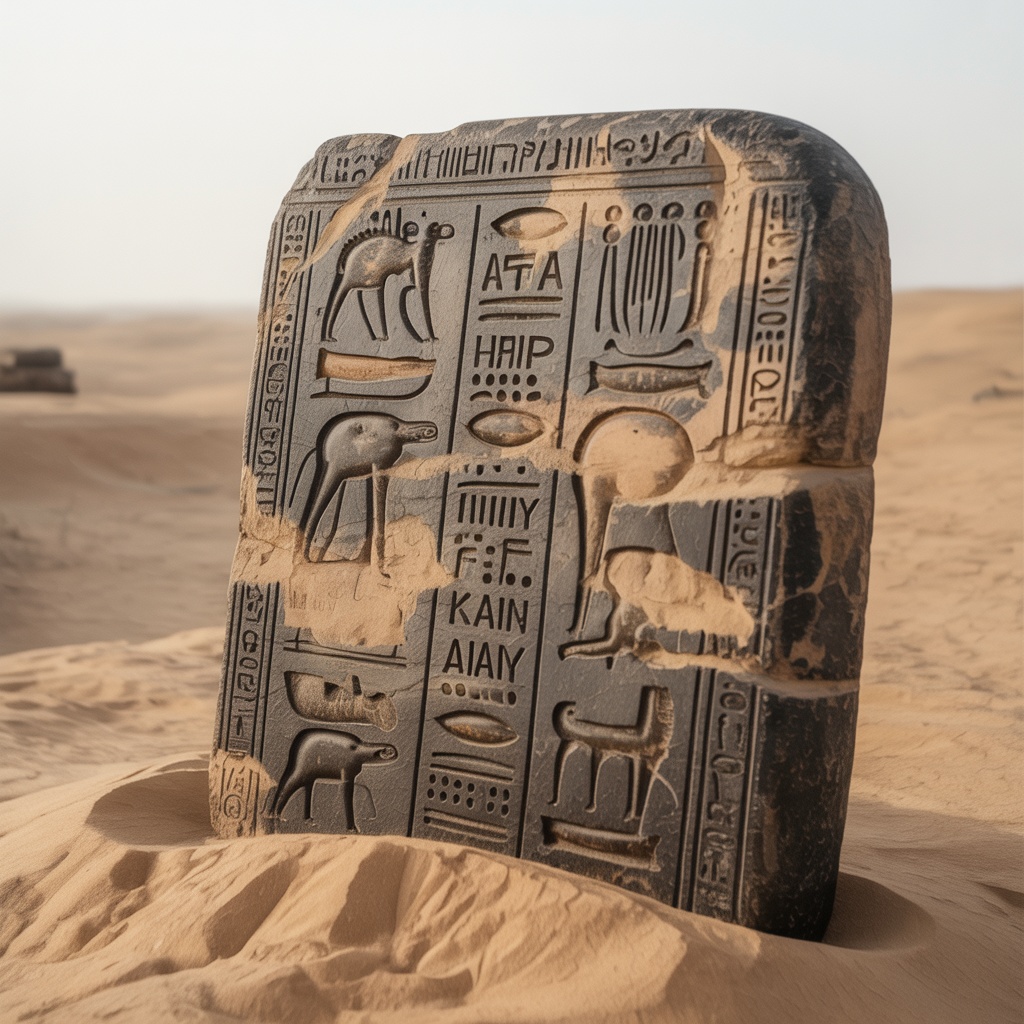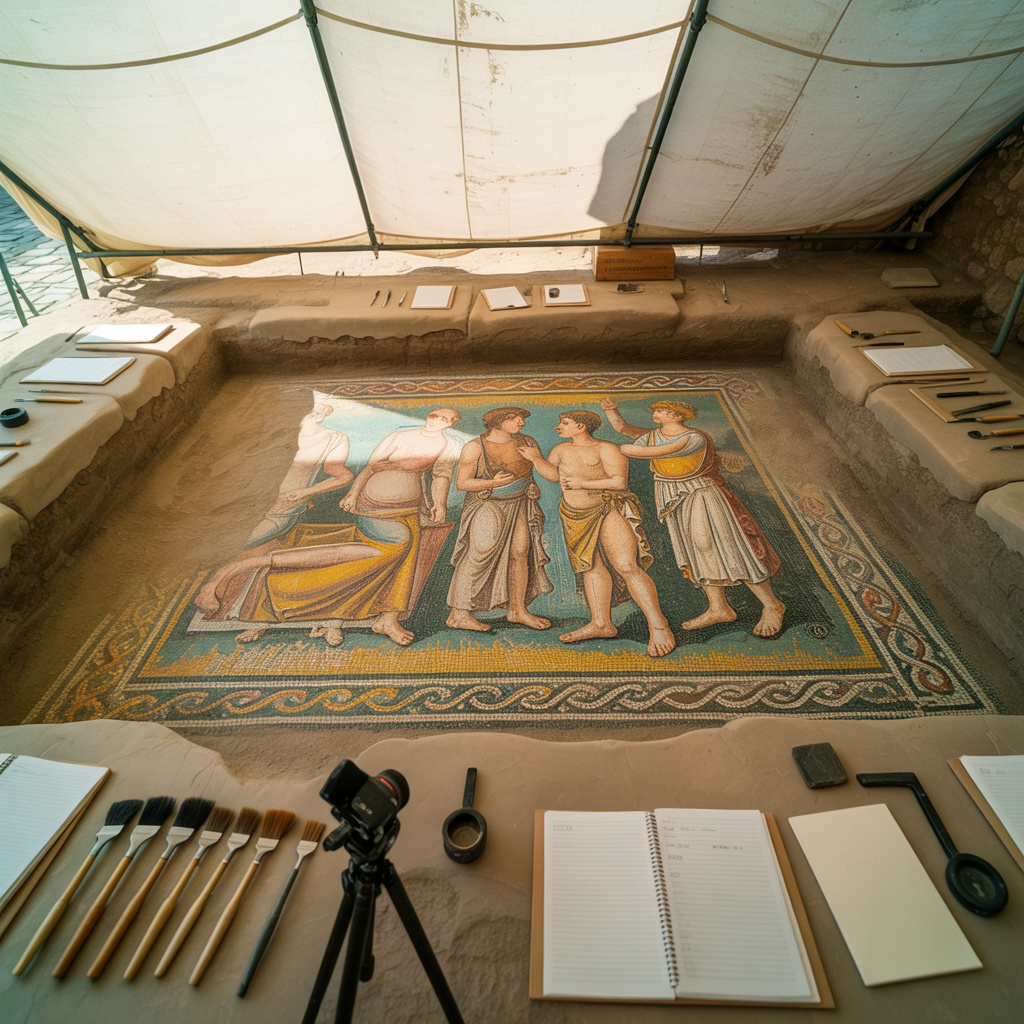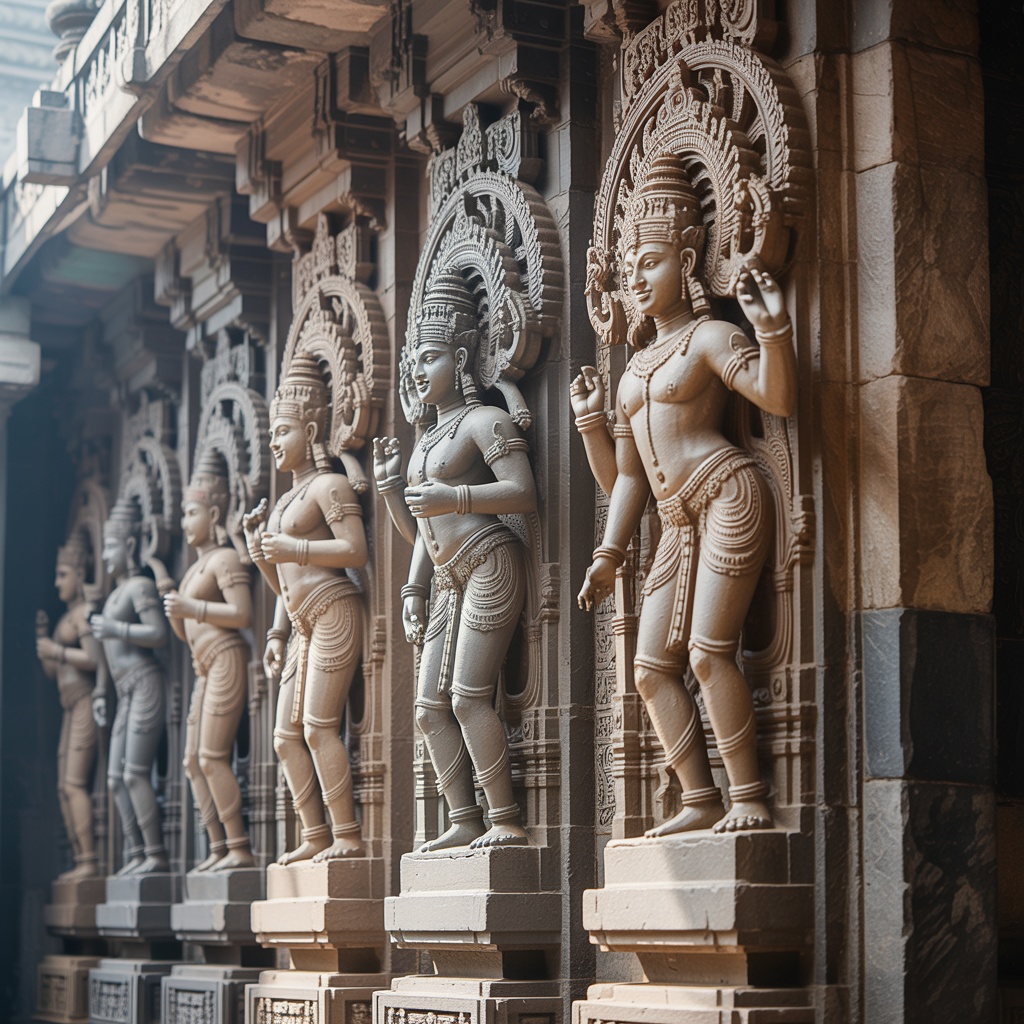The Hoysaleswara Temple at Halebidu in Karnataka, India, represents one of medieval India's most extraordinary architectural achievements. Constructed during the 12th century CE under Hoysala dynasty patronage, this temple complex features thousands of exquisitely detailed stone carvings depicting gods, goddesses, celestial beings, animals, and mythological scenes. Among these masterworks, certain carvings have attracted attention from alternative archaeology proponents who interpret specific figures as ancient astronauts—extraterrestrial visitors allegedly documented by medieval Indian sculptors. These claims require careful examination through proper understanding of Hoysala artistic conventions, Hindu iconography, and rigorous archaeological methodology.
As specialists in archaeological heritage interpretation, we've guided numerous visitors through Halebidu's magnificent carvings whilst addressing questions about controversial interpretations. This comprehensive analysis examines the temple's historical context, the specific carvings generating ancient astronaut theories, conventional art historical interpretations, and why evidence-based archaeology rejects extraterrestrial explanations whilst celebrating the genuine artistic and cultural achievements these sculptures represent.
The Hoysaleswara Temple: Historical and Cultural Context
Understanding Halebidu's carvings requires first appreciating the temple's historical circumstances and artistic tradition. Construction began around 1121 CE under King Vishnuvardhana, though the temple was never completed despite decades of work involving hundreds of sculptors. The Hoysala artistic style represents the culmination of centuries of South Indian temple architecture, characterized by elaborate stone carving, complex geometries, and iconographic programs integrating religious narratives with royal propaganda.
Hoysala Artistic Traditions
Hoysala sculptors developed distinctive stylistic features including extremely intricate surface decoration, figures carved in high relief with extraordinary detail, complex compositions layering multiple narrative elements, distinctive treatment of jewelry and costume details, and characteristic facial features and body proportions. These artistic conventions followed established rules transmitted through sculptural lineages, ensuring that iconographic representations remained recognizable across different temples and time periods whilst allowing individual artistic expression within conventional parameters.
The sculptors worked from religious texts, artistic tradition, and patron specifications to create programs communicating complex theological concepts, historical events, and cosmological understanding. Every element—pose, hand gesture, attributes, associated figures—carried specific meaning within Hindu iconographic systems. Modern viewers unfamiliar with these conventions may misinterpret elements that would have been immediately comprehensible to intended medieval audiences.
The "Ancient Astronaut" Carvings

Specific carvings at Halebidu have been interpreted by ancient astronaut theorists as depicting space-faring beings. These typically include figures appearing to wear helmet-like headgear, beings shown within circular or oval frames resembling spacecraft, figures in unusual postures interpreted as operating control mechanisms, and entities with attributes suggesting technology rather than traditional divine iconography.
Analyzing Specific Examples
The "helmeted" figures typically represent Hindu deities wearing kirita makuta crowns—elaborately ornamented royal headdresses standard in medieval Indian iconography. These crowns follow established artistic conventions documented across hundreds of temples and thousands of sculptures. The "helmet" interpretation reflects unfamiliarity with Hindu artistic tradition rather than evidence of anomalous imagery.
Circular frames surrounding certain figures represent prabhamandala or aureoles—symbolic devices indicating divine status, not spacecraft. This artistic convention appears throughout Indian art spanning two millennia, representing divine radiance or cosmic significance. Similar devices appear in Christian art (halos), Buddhist art (mandorlas), and various other traditions—recognizing these as conventional artistic language rather than literal spacecraft prevents misinterpretation.
Unusual postures or hand positions follow mudra conventions—ritual gestures with specific religious meanings. Each finger position, hand orientation, and arm placement communicates particular concepts within Hindu devotional practice. Interpreting these as operating spacecraft controls demonstrates ignorance of mudra meaning rather than identifying genuine anomalies.
Understanding Hindu Iconography
Hindu iconography developed sophisticated visual language communicating complex theological concepts through standardized artistic conventions. Understanding these systems reveals that "ancient astronaut" interpretations fundamentally misread culturally-specific artistic communication:
Celestial Vehicle Conventions
Hindu mythology describes various vimana—celestial vehicles used by gods and heroes. These are depicted in temple sculpture following established artistic conventions that don't resemble modern spacecraft but rather floating palanquins, elaborate chariots, or lotus thrones. The vimana concept represents divine mobility and transcendence rather than documenting literal flying machines—mythological narrative rather than technological specification.
Divine Attributes and Symbolism
Hindu deities appear with specific attributes identifying them and indicating their cosmic functions—Vishnu with chakra and shankha, Shiva with trident and damaru drum, Brahma with prayer beads and water vessel. These attributes follow strict iconographic rules ensuring deities remain recognizable. Misinterpreting these conventional attributes as technological devices reflects cultural unfamiliarity rather than identifying anomalies requiring extraordinary explanations.
The Ancient Astronaut Hypothesis: Origins and Critique

The ancient astronaut hypothesis proposes that extraterrestrial beings visited Earth in antiquity, influencing human civilization and being remembered in mythology and art. This theory, popularized by books like Erich von Däniken's "Chariots of the Gods," interprets various ancient artifacts, structures, and artworks as evidence of alien contact.
Methodological Problems
Ancient astronaut interpretations suffer from several fundamental methodological flaws. They demonstrate cultural insensitivity by assuming ancient peoples couldn't achieve impressive accomplishments without extraterrestrial assistance—a position that often implicitly denigrates non-Western cultures' intellectual capabilities. The approach employs selective evidence by highlighting ambiguous cases whilst ignoring vast bodies of conventional evidence and established archaeological understanding. It uses circular reasoning where any unexplained aspect of ancient culture becomes "evidence" for alien contact whilst alternative explanations are dismissed without adequate consideration.
Additionally, the hypothesis violates Occam's Razor—the principle that simpler explanations requiring fewer unsupported assumptions should be preferred over complex ones. When conventional art historical interpretation easily explains Halebidu's carvings through well-documented Hindu iconographic traditions, proposing instead that they document alien visitors requires accepting numerous additional unsupported assumptions including alien existence, their Earth visits, their interaction with medieval Indians, and the specific documentation of these encounters in temple sculpture.
What Halebidu's Carvings Actually Represent
Professional art historians and archaeologists recognize Halebidu's sculptures as masterful expressions of Hindu theology, Hoysala political propaganda, and medieval Indian artistic achievement:
Religious Narratives
Many carvings depict scenes from Hindu epics including the Ramayana and Mahabharata, Puranic stories about gods and their exploits, devotional representations of Vishnu, Shiva, and their various manifestations, and cosmological concepts including the structure of the universe and cycles of creation and destruction. These narratives communicate religious teachings whilst providing visual focus for devotional practice.
Royal Legitimization
Temple sculpture served political functions, establishing royal legitimacy through association with divine authority, demonstrating royal wealth and power through monumental construction, commemorating military victories and territorial expansion, and documenting dynastic lineages and achievements. The Hoysala rulers who commissioned Halebidu intended the temple to broadcast their prestige and religious devotion—functions successfully achieved through the extraordinary sculptural program.
Artistic Virtuosity
The sculptures demonstrate extraordinary technical skill including ability to carve extremely hard schist stone with minute precision, creation of deeply undercut high-relief figures that appear almost freestanding, rendering of fine details including jewelry, textiles, and facial expressions, and composition of complex multi-figure scenes within limited surface areas. This artistic achievement deserves celebration in its own right, without requiring extraterrestrial explanations that actually diminish appreciation for human artistic capability.
Visiting Halebidu Temple

The Hoysaleswara Temple remains an active religious site and major tourist destination in Karnataka:
Location and Access
Halebidu is located approximately 30 kilometres from Hassan town and 150 kilometres from Bangalore. The site is easily accessible by road and can be visited as a day trip from Hassan or combined with nearby Hoysala temples at Belur and Somnathpur. The temple complex is open daily from sunrise to sunset, with modest entry fees (free for Indian nationals, small charge for foreign tourists).
What to See
The temple features two main shrines dedicated to Shiva, each with separate sanctums but sharing a common platform. The exterior walls display registers of sculpted figures including elephants, lions, horsemen, dancers, musicians, and divinities. The basement frieze contains over 2,000 elephants in various poses, no two identical—a testament to sculptural creativity. The interior features elaborately carved pillars, ceiling panels, and doorways demonstrating Hoysala architectural sophistication.
Best Time to Visit
Karnataka's climate creates distinct visiting seasons. October through March offers comfortable temperatures (15-30°C) ideal for exploring outdoor sites. April through June brings heat (30-40°C) that can make midday uncomfortable. Monsoon season (June-September) brings rain that may disrupt travel but creates lush landscapes and dramatic lighting for photography. Early morning or late afternoon visits provide the best light for appreciating sculptural details and avoiding midday crowds.
Our India heritage tours arrange expert-guided visits to Halebidu and related Hoysala sites, providing accurate art historical interpretation that reveals the sculptures' actual cultural significance whilst addressing questions about alternative theories.
Related Hoysala Sites Worth Exploring
The Hoysala dynasty commissioned numerous temples across Karnataka, offering opportunities to appreciate their distinctive architectural tradition:
Chennakeshava Temple, Belur
Built to commemorate Hoysala victory over the Cholas in 1116 CE, this temple features sculpture rivaling Halebidu's quality. The famous "Shantala Devi" figure, depicting the queen in mirror pose, demonstrates extraordinary artistic sensitivity. The temple's 48 pillars feature unique designs, showcasing sculptural innovation within iconographic tradition.
Keshava Temple, Somnathpur
This smaller but perfectly preserved temple from 1268 CE represents late Hoysala style. The star-shaped platform and triple shrine design create architectural harmony. The preservation quality allows detailed study of original sculptural programs, offering insights into iconographic planning and execution.
The Value of Accurate Interpretation
Misinterpreting Halebidu's carvings as ancient astronauts doesn't just represent harmless speculation—it actively undermines appreciation for genuine achievements:
Diminishing Human Achievement
Attributing ancient accomplishments to alien intervention implicitly suggests human incapability—that our ancestors couldn't achieve remarkable results through intelligence, skill, and effort. This perspective disrespects ancient peoples' genuine capabilities whilst promoting passive rather than active understanding of history.
Obscuring Cultural Meaning
Alternative interpretations divorced from cultural context prevent understanding what ancient peoples actually created and intended to communicate. Halebidu's sculptures tell stories about Hindu theology, Hoysala politics, medieval Indian society, and artistic tradition—meanings lost when sculptures are misinterpreted as documenting alien contact.
Undermining Archaeological Education
Promoting unfounded theories makes genuine archaeological education more challenging. When people accept ancient astronaut claims, they develop resistance to evidence-based archaeology, viewing legitimate scholarship as narrow-minded orthodoxy suppressing revolutionary ideas rather than rigorous methodology distinguishing verified knowledge from speculation.
How to Evaluate Archaeological Claims
The Halebidu ancient astronaut case provides lessons in evaluating archaeological claims:
- Understand cultural context: Before proposing exotic interpretations, learn what conventional cultural understanding suggests—most "mysteries" dissolve with proper contextual knowledge
- Consult expert interpretation: Art historians and archaeologists specializing in relevant cultures can explain iconographic conventions and artistic traditions that resolve apparent anomalies
- Apply Occam's Razor: Prefer simpler explanations requiring fewer unsupported assumptions over complex ones demanding acceptance of extraordinary claims
- Examine comparative evidence: Look for similar imagery across multiple sites and periods—patterns revealed through comparison usually indicate conventional artistic traditions rather than unique anomalies
- Consider alternative explanations: Before accepting extraordinary claims, ensure simpler alternative explanations have been fairly evaluated and legitimately ruled out
Applying these principles to Halebidu reveals that conventional art historical interpretation easily explains the carvings, whilst ancient astronaut theories require accepting numerous extraordinary unsupported claims. Similar analytical approach helps evaluate other controversial archaeological interpretations, distinguishing genuine mysteries from misunderstandings of cultural context.
Conclusion: Celebrating Genuine Achievement
Halebidu's sculptures represent extraordinary human achievement in stone carving, architectural planning, and cultural expression. Medieval Hoysala sculptors created masterworks communicating complex religious and political concepts through sophisticated visual language refined across centuries of artistic tradition. These accomplishments deserve celebration and understanding on their own terms—as products of human creativity, skill, and devotion—rather than being misappropriated to support unfounded theories about ancient alien contact.
Visiting Halebidu with proper understanding of Hindu iconography and Hoysala artistic conventions reveals meanings and achievements invisible to viewers misinterpreting the sculptures through alien theories. Our interpretation services provide this contextual knowledge, ensuring visitors appreciate both the artistic mastery and cultural significance of these remarkable medieval Indian monuments.
